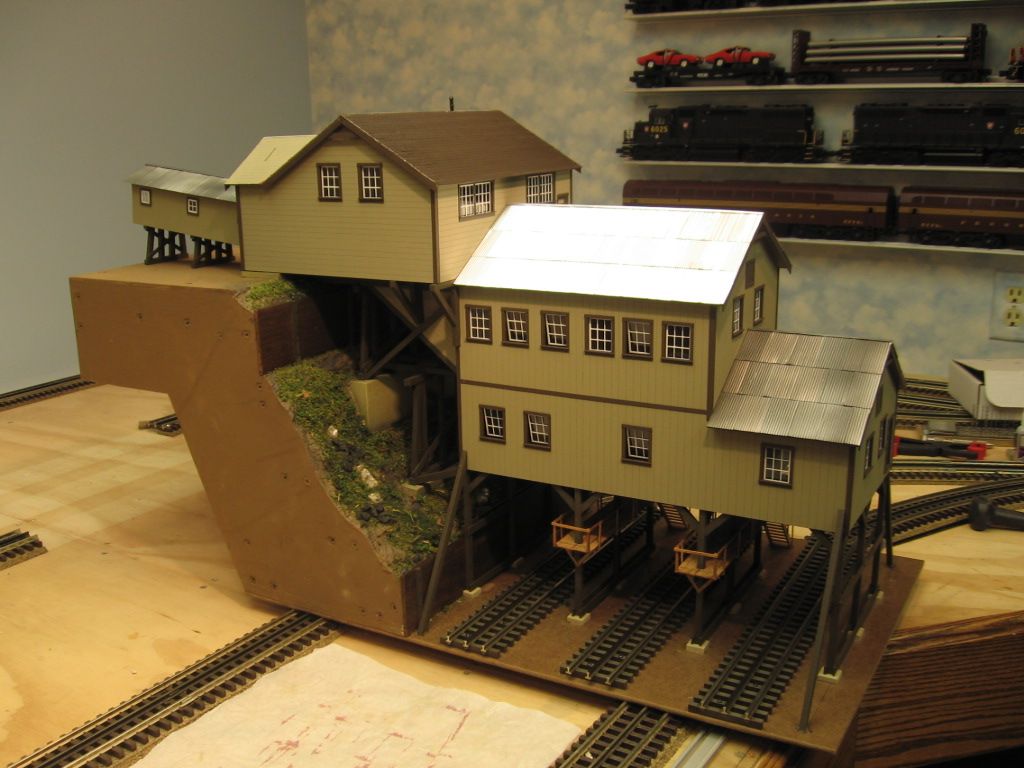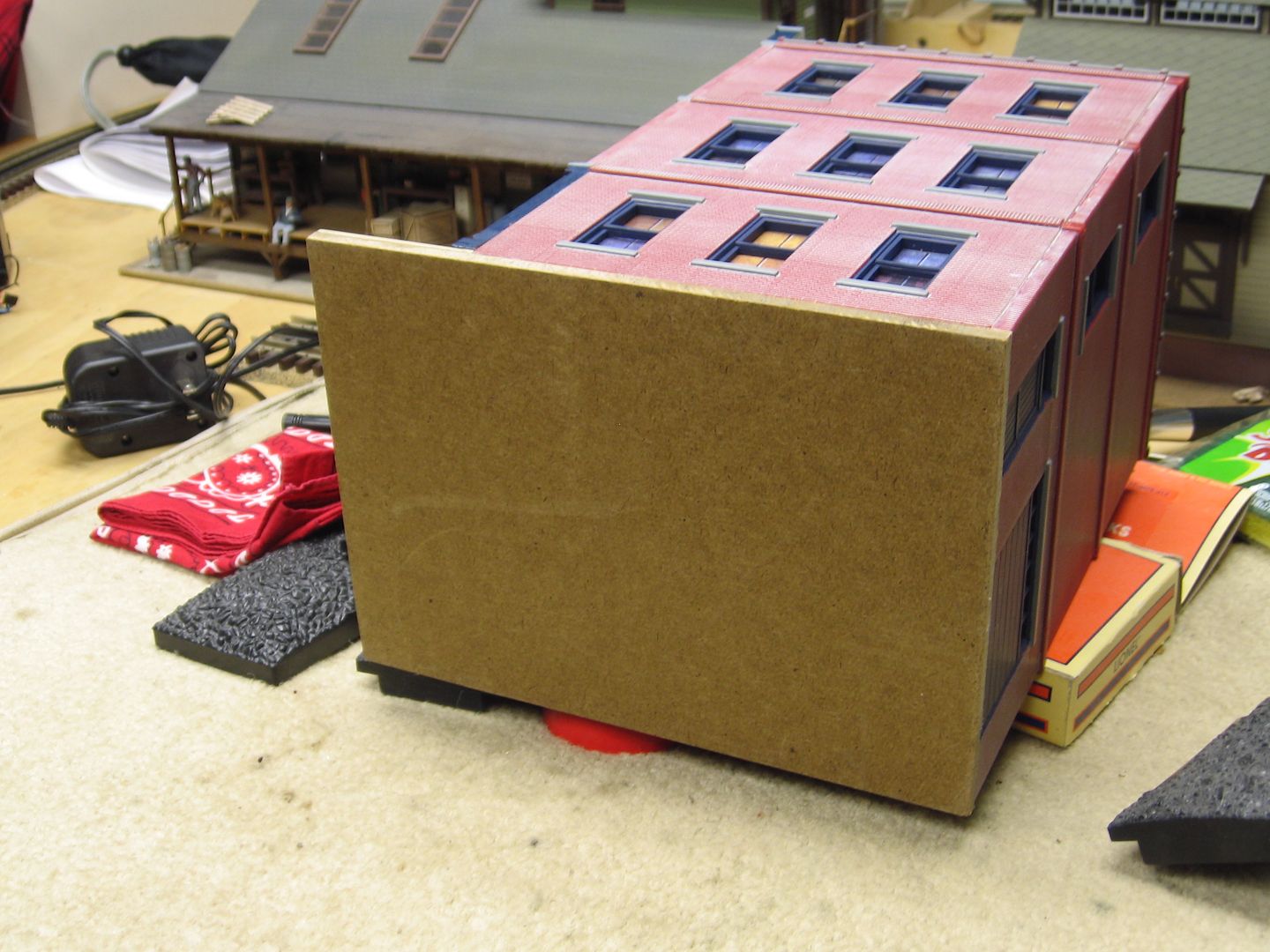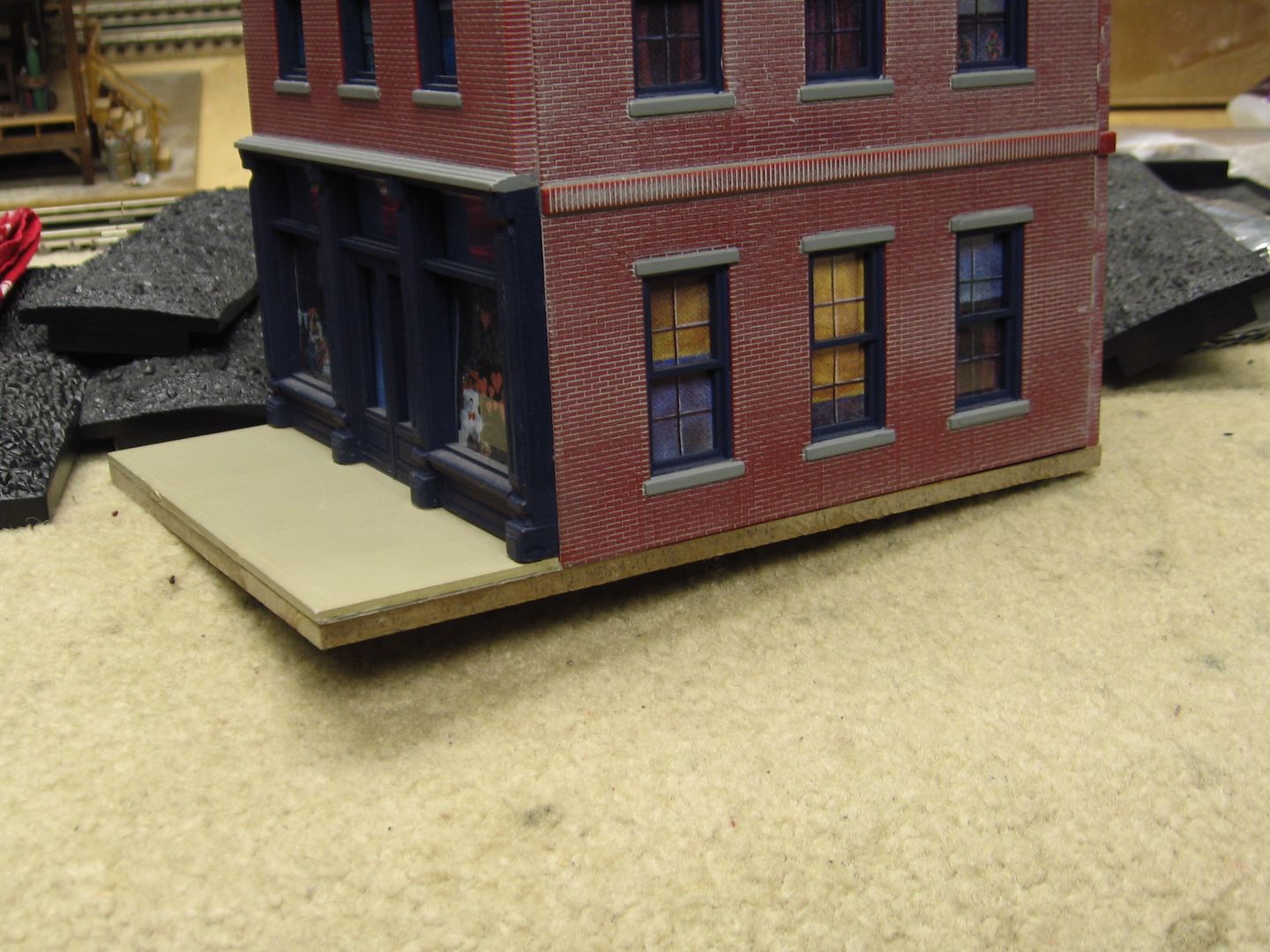The track is down and ballasted. Not sure which should come first. Do you guys have any preference or reasons for one over the other first?
Thanks,
Andy
|




|
The track is down and ballasted. Not sure which should come first. Do you guys have any preference or reasons for one over the other first?
Thanks,
Andy
Replies sorted oldest to newest
Whichever one you put in first you will swear you should have done the other one first! I find it easiest to do an area of buildings and scenery at one time, then move on to the next area. In that way you have a mostly finished area that will motivate you to go on to the next area.
You will need to block out where your large scenic elements will go and the footprints of your buildings so you can be certain all will fit. I put in the scenic elements first, then the buildings in most cases, though in one area I did it the other way around as the scenery there will be fairly minimal. Also plan for holes to route wires, pop-ups, access holes, etc. If something is where you can't reach it, that's where you will have a problem.
Good luck with your layout!
Trainfun posted:Whichever one you put in first you will swear you should have done the other one first! I find it easiest to do an area of buildings and scenery at one time, then move on to the next area. In that way you have a mostly finished area that will motivate you to go on to the next area.
You will need to block out where your large scenic elements will go and the footprints of your buildings so you can be certain all will fit. I put in the scenic elements first, then the buildings in most cases, though in one area I did it the other way around as the scenery there will be fairly minimal. Also plan for holes to route wires, pop-ups, access holes, etc. If something is where you can't reach it, that's where you will have a problem.
Good luck with your layout!
Yup! Pretty much the right of it - I'll decide where a structure will go and then before planting it think through what the scenery will be around it to make sure I can get in to it to install it all,
Also, whatever you do, work back to front - you don't want to be reaching over or through stuff, ![]()
I agree with Trainfun. If you have already established a firm design of the layout elements and measured and tempoarily placed the buildings in their final location, then you could trace footprint for the buildings, mask off those areas, install or paint the roads, mask those off and then do the trees and grass. Gluing down the ground cover grass and bushes can get messy and it's easier IMO to do so without buildings in the way. Just a thought.
Edit. MWB, just saw your reply. We are of like mind.
Andy,
We started with an area (section) first that included buildings and scenery at the same time. Laid the buildings in their spot and scenery was next to make it look good. We also worked back to front which was mentioned and is smart. If we had grass next to the building we outlined the building on the layout then removed the bldg then added the grass, then replaced the bldg in its spot. This way we didn't get grass or glue on the sidewalk, building. Sounds like good progress is being made.
Mike
Thank you for your responses. Now I can start thinking in terms of specific areas and projects.
Andy
While all that's said, you can still build structures and not install them yet. Just scenery is boring and just structures is a bit strange so you need to do both. I started with the town and engine services, and then went to some serious terrain work, back to buildings and then to more serious terrain work. The big terrain work shuts off the trains during construction, so it's good to do that in phases so you're not having trains sitting with draining batteries for a year.
As others have said, work on areas, adding both scenery and buildings together. It'll come out like you want it to that way!
Yes. If you do structures before then the scenery ends up looking like an afterthought. If you don't take your structures into account before doing scenery, it is harder to fit the structures in.
Plan your layout based on a well thought out placement plan of buildings, streets & waterways first then add the tracks around that concept. Everything else will fall into place after that.
Recently installed a gas line to our new furnace over the layout. The Access hole was a plus, Those modular items that could be removed also a plus. A lot of the layout has buildings, on very good bases, that can be easily moved. Currently several of the model buildings are on display, at a local McDonald's store, there is a glass show case.
Access hole, all the farm items were easily removed.

The coal tipple is on display at a local McDonald's. The module, with care, moves easily.



The hardware/supply is also displayed.

These OGR building also move easily.



Have fun with your layout build ![]()
Mike CT
Another option that I switched over to a few years ago has been to assemble the structures and surrounding scenery as a unit that I can then "plant" into its location.

Almost every structure on my layout has been mounted onto 1/16" Masonite with the surrounding scenery added - just a bit like assembling a puzzle then, but everything is removable and if/when I get tired of a specific scene I can replace it with minimal disruption to the surroundings.
You are asking this question to someone who should join a 12 step program for structure-holics. I have a lovely little brass locomotive that's been sitting on my workbench for over 2 years. Do I finish it and get it running? NO! My solution is to just build another building.
Thank you to all who have responded. I appreciate it a great deal. Any advice as to what products, ground cover, grasses, etc..a "starter kit" if you will. I'm asking more in terms of product rather than brand (I don't want to start a brand war).The settings will be suburban, focusing on commercial applications. Lumber yard, iron works, meat packing, dairy facility, passenger stations, downtown area.
Thanks,
Andy
Forum Sponsor Scenic Express Click on the link.
Steamfan77 posted:Any advice as to what products, ground cover, grasses, etc..a "starter kit" if you will. I'm asking more in terms of product rather than brand (I don't want to start a brand war).
I use products from Woodland Scenics - turf and ground cover, foliage clusters, various grasses; Scenic Express - use a lot of prairie tufts from Silflor, goldenrod, and all sort of stuff; JTT - flowering shrubs and trees.
Basically, brand is not relevant - use whatever you like that does the job to get you the look you want to achieve. Just stroll through their catalogs - but be careful, you could drown under the possibilities!
mwb posted:Another option that I switched over to a few years ago has been to assemble the structures and surrounding scenery as a unit that I can then "plant" into its location.
Almost every structure on my layout has been mounted onto 1/16" Masonite with the surrounding scenery added - just a bit like assembling a puzzle then, but everything is removable and if/when I get tired of a specific scene I can replace it with minimal disruption to the surroundings.
I am not a fan of this technique, as it often either leads to a 'footprint' in the finished scenery where a symmetrical piece of base is seen in the ground, or you have to cut the structure from it.
It all depends on how well you can disguise the junction. Here're some examples:
Woodbourne Station: Luckily this was not fastened into the benchwork. I had made the loading platform too wide and the trains crashed into it. I had to take the building off the layout and rebuild the platform 1/4 narrower.
Bernheim Distillery: All the buildings are set into sockets permitting clean removal and sale if it ever presents itself. And the entire vignette is also not glued in place so it too can be lifted off if necessary.
Substation: In this case the chain link fence made a natural perimeter. Landscaping filled any gaps.
Idaho Hotel: The building's foundation is what's inserted into the scenery, therefore, all the scenery is natural looking since the foundation has to enter the "ground".
My friend Ashe Rawls, convinced to never glue the buildings into the layout. You never know when you'll have to remove it for repair or sale. I did glue my first structures in before learning this, and sure enough, the loading spout on the sanding tower is broken and I'll have to reattach it where it sits because I'd wreck it more trying to extricate it.
Hi,
Love the Sub-Station. Being that I worked in the Industry.
Where did you purchased it at ?
Thanks, John kb2agpjohn@aol.com
You can't find it since I built it. You can follow all of the gory and wonderful steps on my long-running build thread on this forum at:
https://ogrforum.com/t...he-pandampprr?page=9.
This address brings you to page 9. The first part of that page details building utility poles with transformers which made me think I needed a substation. I was first just going to jazz up the transformer load on my MTH heavy duty flat car, but didn't want to destroy the car's value so I started on a year-long odyssey to build a complete station. The transformer was freelance based on a composite of many power transformers, but the rest are all direct copies of real ABB 145,000 volt breakers, switches and current transformers. The low V side is also a 30,000 V ABB vacuum breaker.
Some of my readers worked in the power industry and were very helpful in providing direct guidance and steering me to good sources.
The thread goes on for many pages and it was also featured in an 8 page article in the November 2015 Railroad Model Craftsman mag. ABB themselves was going to publish it in their internal newsletter, but it was bumped before publication. Being that it's not glued down, it could someday be sold.
O k , Thanks.
p51 posted:mwb posted:Another option that I switched over to a few years ago has been to assemble the structures and surrounding scenery as a unit that I can then "plant" into its location.
Almost every structure on my layout has been mounted onto 1/16" Masonite with the surrounding scenery added - just a bit like assembling a puzzle then, but everything is removable and if/when I get tired of a specific scene I can replace it with minimal disruption to the surroundings.
I am not a fan of this technique, as it often either leads to a 'footprint' in the finished scenery where a symmetrical piece of base is seen in the ground, or you have to cut the structure from it.
Depends entirely on the quality of (1) how good your scenery efforts are in joining stuff together and (2) how good your joining together is of the Masonite itself - there are no gaps between my bits of Masonite. A little bit of ground cover sprinkled in place over the seam and there is no seam.
Would you rather have to cut the structure from the layout? I had to take too many layouts apart with a Sawzzall and watch the structure be totally destroyed by that effort. Cutting them loose simply does not work. Ok, leave them loose - then your scenery up to the structure (1) better be good, and (2) also loose since if you glue it down that glue is going to leach under the structure and it will get glued to the layout.
Now if you don't actually care about your scenery and structures, well then then that's another story altogether.
All of the buildings on my layout have electronics in them.
For example . . .
https://www.youtube.com/watch?v=hmYsWfxiHTk&t=4s
It would be madness to glue them in.
Cheers
I like Trainman's method. There seems to be a constant stream of new structures being offered. It would really be nice to just be able to lift out an older building if some new building caught my eye. Scenery and structures is not far away so I might try that technique.
Thanks for the idea,
Ed
Wow, thanks for all of the great ideas and opinions. Like anything else I'll start experimenting and see what produces the best final product (as far as my skills will take me ![]() ). I agree that the structures should have the flexibility of being removable. I'll be doing just that on my access hatch in the yard.
). I agree that the structures should have the flexibility of being removable. I'll be doing just that on my access hatch in the yard.
Andy
I always start with the buildings and scene around them so they don't look like they were dropped onto table top as an after thought. I always start with fine ground foam, earth, grass then weeds. Next comes the static grass in varying colors then Silflor grass tufts and larger foliage finally larger trees and bushes. This way it's uniform all the way up to the building or accessory.
Paul
Access to this requires an OGR Forum Supporting Membership
